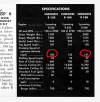Unrelated but with everyone seemingly going for the 160hp conversion, why was the true Cherokee 160 so short-lived?
It had to do with avgas and economics.
While today nearly all piston GA airplanes use the same 100LL fuel, in the day of the Cherokee 160 there were commonly three grades available -- 80/87 octane, 91/96 octane, and 100/115 octane. The higher grades, predictably, were more expensive.
While the first Cherokee to fly was the PA-28-150, the PA-28-160 was the first to be certified and go into production in mid 1961. The 150-hp model followed a few months later, and the 180-hp model in late 1962.
According to Piper's book figures, compared to the Cherokee 150, the Cherokee 160 offered 45 lb more useful load, 2 mph higher cruising speed, and a higher ceiling, all for only $500 more purchase price.
So why would anybody buy a Cherokee 150? Because the Cherokee 150 could use the cheaper 80-octane fuel, while the 160 required the more expensive 91-octane at a minimum, and at airports where 91-octane was not available, the Cherokee 160 pilot would have to spring for 100-octane. Even though there was minimal difference in fuel consumption between the -150 and the -160, the price of fuel made the -160's operating expenses significantly higher.
Piper discontinued the Cherokee 150 and 160 in late 1967, going forward with only the Cherokee 140 trainer (with the same engine as the old -150, but smaller rear cabin and no baggage door), and the wildly popular Cherokee 180 (and 235 and the new Arrow 180).
The 160 hp O-320 was little used in new aircraft for several years, one notable exception being the Twin Comanche. In the mid 1970s came the push to consolidate all avgas production into the single 100LL grade, and the cheaper 80 and 91 octane grades were phased out. Though it was understood that engines built for 80 octane could run on higher grades, it soon became apparent that a steady diet of 100LL in the lower-compression engines was leading to chronic lead fouling and other issues. That's why there was a sudden renaissance of 160 hp engines in 1977, when both the Cherokee Warrior and Cessna 172 switched from 150 hp to higher-compression 160 hp variants of the Lycoming O-320. There was no longer a fuel price disadvantage to those higher-compression engines. That also explains the popularity of the more recent 160 hp conversions.






